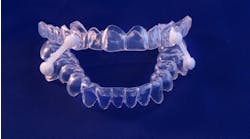Dental pain: Can we predict who has a higher risk prior to treatment?
Originally published March 6, 2019. Updated February 7, 2022.
Pain and discomfort after dental procedures can be patient-specific and trying to predict which patients will experience pain and to what degree can be unpredictable. Some patients who have had invasive surgical procedures may experience no pain when pain should be expected, while others who have undergone a minor, minimally invasive procedure may call your after-hours service in agony.
Pain management after dental procedures has been given increased attention since the opioid epidemic came into national focus, and practitioners have been discouraged from administering narcotics simply because a patient states they have pain. Many tests have been developed in the medical field to try to predict the patient who is at risk for pain prior to surgical treatment. Inserting a cannula into a vein on the back of the hand and eliciting a pain score prior to surgical laparoscopy has been a predictive method.1
Other preoperative pain predictive tests have been used with some success (up to 54% predictive value) to try to ascertain which patient is more likely to experience postoperative pain. These tests include using a blood pressure cuff to measure pain through mechanical pressure,2 using electrical stimuli to measure pain response,3 and using extreme temperature to determine pain.4 These tests are rarely used in dentistry in favor of other measures, which include minimally invasive dentistry utilizing instruments, surgical techniques, computer-assisted anesthetic delivery systems, and long-lasting nonopioid analgesics to minimize postprocedural discomfort.
Related reading:
- Top 5 sources of dental implant pain when "there is nothing wrong with the implant"
- Tooth pain after root canal therapy: The 5 common causes
Many articles in the literature suggest that certain general patient characteristics, when recognized, can have a high predictive value of postoperative pain.5 In this article, I’ll briefly describe the top five preoperative factors and patient characteristics that lead to postprocedural pain and the need for analgesics. With this knowledge, dental professionals can better anticipate various levels of dental pain and thus respond proactively.
5 characteristics that can predispose a patient to pain
1. Anxiety
According to numerous studies, the number one predictor of preoperative pain is someone who experiences anxiety prior to the dental procedure.6 Furthermore, anxious dental patients can be categorized into three different types:
- Patients who are only anxious prior to dental procedures but in general are not anxious.7 For these patients, postoperative pain can be lowered with some form of sedation.
- Patients with psychological stress who are generally nervous and tend to catastrophize or have a negative assessment of the situation (i.e., think the worst outcome will be inevitable). These patients think the procedure is going to hurt postoperatively despite what they are told. Distraction mechanisms (taking the patient's mind off the procedure) have been shown to positively benefit these patients in terms of minimizing postoperative pain.
- Patients with poor coping skills tend to have higher intensities of postprocedural pain than patients with good coping skills. Good coping skills include information-seeking behavior (perhaps they google the procedure prior to treatment), strong emotional support systems, and possession of religious beliefs.8
2. Preoperative pain
The second predictive characteristic for pain is a patient who already experienced pain and/or has a low pain threshold prior to a dental procedure. These patients present with pain from an infection, trauma, and/or acute disease.9 In order to reduce pain, these patients may benefit from antibiotic and anti-inflammatory medication for a period of time prior to a dental procedure.
3. Type and length of procedure
In general, patients who are undergoing long, invasive dental procedures experience more postoperative pain than patients undergoing shorter, minimally invasive procedures. One study suggests that if a surgical procedure can be shortened by 10 minutes, moderate to severe postoperative pain can decrease as much as 40%.10
4. Age
Many studies have found that younger patients have both higher postprocedural pain and require more analgesics.11 Although there is no consensus in the literature, the proposed suggestion for age-related postprocedural pain is that older patients may have blunted peripheral nociceptive function, decreasing pain in some contexts and reducing the need for postprocedural analgesia. However, confounding variables do exist in the elderly population, and patients who are already experiencing chronic pain and/or are taking pain medication may not fall into this category.
5. Red hair
Although the science on this topic is scarce, the literature has shown that patients with red hair are more likely to experience postoperative pain and have a diminished response to dental anesthesia (local) when compared to patients who do not have red hair. The possible mechanism of this phenomena is that red hair is the phenotype for mutations of the melanocortin 1 receptor. Studies suggest that redheads are more sensitive to thermal pain and resistant to the analgesic effects of subcutaneous lidocaine. Mutations of the melanocortin 1 receptor, or a consequence thereof, modulate pain sensitivity.12 The good news is that redheads may respond better to postprocedural analgesia and require lower doses than nonredheaded patients.13
Conclusion
Every patient is different, and pain is a multifactorial, dynamic topic that requires much more research. Personalized dentistry and DNA sequencing may solve some of the mysteries of pain management. However, in general, if an anxious, young redheaded patient who is experiencing severe tooth pain presents for treatment requiring a lengthy, invasive surgical extraction, you may want to warn that individual that the following days may not be pleasant.
Editor’s note: This article originally appeared in Perio-Implant Advisory, a chairside resource for dentists and hygienists that focuses on periodontal- and implant-related issues. Read more articles and subscribe to the newsletter.
References
- Peng F, Li Y, Ai Y, Yang J, Wang Y. Application of preoperative assessment of pain induced by venous cannulation in predicting postoperative pain in patients under laparoscopic nephrectomy: a prospective observational study. BMC Anesthesiol.2020;20(1):86 doi:1186/s12871-020-01003-z
- Rago R, Forfori F, Materazzi G, et al. Evaluation of a preoperative pain score in response to pressure as a marker of postoperative pain and drugs consumption in surgical thyroidectomy. Clin J Pain. 2012;28(5):382-386. doi:10.1097/AJP.0b013e3182326495
- Nielsen PR, Nørgaard L, Rasmussen LS, Kehlet H. Prediction of post-operative pain by an electrical pain stimulus. Acta Anaesthesiol Scand. 2007;51(5):582-586. doi:1111/j.1399-6576.2007.01271.x
- Strulov L, Zimmer EZ, Granot M, Tamir A, Jakobi P, Lowenstein L. Pain catastrophizing, response to experimental heat stimuli, and post-cesarean section pain. J Pain. 2007;8(3):273-279. doi:1016/j.jpain.2006.09.004
- Trikha A, Singh PM. Predicting post-operative pain: still a long way to go! J Anaesthesiol Clin Pharmacol. 2013;29(4):433-444. doi:4103/0970-9185.119105
- Taenzer P, Melzack R, Jeans ME. Influence of psychological factors on postoperative pain, mood and analgesic requirements. Pain. 1986;24(3):331-342. doi:10.1016/0304-3959(86)90119-3
- Ye H, Chen R, Lian X, et al. Risk factors associated with postoperative pain and discomfort in oculoplastic surgery with general anesthesia: a prospective study. J Pain Res. 2018;11:407-415. doi:10.2147/JPR.S156104
- Perry F, Parker RK, White PF, Clifford PA. Role of psychological factors in postoperative pain control and recovery with patient-controlled analgesia. Clin J Pain. 1994;10(1):57-63. doi:10.1097/00002508-199403000-00008
- Mamie C, Bernstein M, Morabia A, Klopfenstein CE, Sloutskis D, Forster A. Are there reliable predictors of postoperative pain? Acta Anaesthesiol Scand. 2004;48(2):234-242. doi:10.1111/j.0001-5172.2004.00298.x
- Griffin TJ, Cheung WS, Zavras AI, Damoulis PD. Postoperative complications following gingival augmentation procedures. J Periodontol.2006;77(12): 2070-2079. doi:10.1902/jop.2006.050296
- Ip HYV, Abrishami A, Peng PWH, Wong J, Chung F. Predictors of postoperative pain and analgesic consumption: a qualitative systematic review. Anesthesiology.2009;111(3):657-677. doi:10.1097/ALN.0b013e3181aae87a
- Liem EB, Joiner TV, Tsueda K, Sessler DI. Increased sensitivity to thermal pain and reduced subcutaneous lidocaine efficacy in redheads. Anesthesiology. 2005;102(3):509-514. doi:10.1097/00000542-200503000-00006
- Bryant E. Study finds link between red hair and pain threshold. National Institutes of Health. April 20, 2021. https://www.nih.gov/news-events/nih-research-matters/study-finds-link-between-red-hair-pain-threshold









